Analysis of Thermal Comfort under Different Exercise Modes in Winter in Universities in Severe Cold Regions
Abstract
:1. Introduction
2. Research Methods
2.1. Overview of the Study Population
2.2. Data Collection
2.3. Questionnaire Survey Design
2.4. Activity Level Calculation
3. Analysis of Measurement and Questionnaire Results
3.1. Thermal Sensation Statistics
3.2. The Relationship between Exercise Volume and Thermal Comfort
3.3. Correlation between Physiologically Equivalent Temperature and Mean Thermal Sensory Vote
3.4. Relationship between Place of Origin and Thermal Comfort
3.5. Correlation between Outdoor Activity Time and Thermal Comfort
3.6. Thermal Sensory and Microclimate Factor Models of Different Exercise Modes
4. Discussion
5. Conclusions
Author Contributions
Funding
Institutional Review Board Statement
Informed Consent Statement
Data Availability Statement
Conflicts of Interest
References
- Keller, M.C.; Fredrickson, B.; Ybarra, O.; Cté, S.; Johnson, K.; Mikels, J.; Conway, A.; Wager, T. A Warm Heart and a Clear Head: The Effects of Weather on Human Mood and Cognition. Soc. Sci. Electron. Publ. 2005, 16, 724–731. [Google Scholar]
- Scott, D.; Freitas, C.D.; Matzarakis, A. Adaptation in the Tourism and Recreation Sector. In Biometeorology for Adaptation to Climate Variability and Change; Springer: Dordrecht, The Netherlands, 2009; pp. 171–194. [Google Scholar]
- Fang, Z.; Xu, X.; Zhou, X.; Deng, S.; Wu, H.; Liu, J.; Lin, Z. Investigation into the thermal comfort of university students conducting outdoor training. Build. Environ. 2018, 149, 26–38. [Google Scholar] [CrossRef]
- Elnabawi, M.H.; Hamza, N.; Dudek, S. Thermal perception of outdoor urban spaces in the hot arid region of Cairo, Egypt. Sustain. Cities Soc. 2016, 22, 136–145. [Google Scholar] [CrossRef]
- Höppe, P. The physiological equivalent temperature–A universal index for the biometeorological assessment of the thermal environment. Int. J. Biometeorol. 1999, 43, 71–75. [Google Scholar] [CrossRef]
- Cheng, V.; Ng, E.; Chan, C.; Givoni, B. Outdoor Thermal Comfort Study in a Sub-Tropical Climate: A Longitudinal Study Based in Hong Kong. Int. J. Biometeorol. 2012, 56, 43–56. [Google Scholar] [CrossRef]
- Thorsson, S.; Honjo, T.; Lindberg, F.; Eliasson, I.; Lim, E.-M. Thermal Comfort and Outdoor Activity in Japanese Urban Public Places. Environ. Behav. 2007, 39, 660–684. [Google Scholar] [CrossRef]
- Lin, T.-P. Thermal perception, adaptation and attendance in a public square in hot and humid regions. Build. Environ. 2009, 44, 2017–2026. [Google Scholar] [CrossRef]
- Mayer, H.; Holst, J.; Dostal, P.; Imbery, F.; Schindler, D. Human Thermal Comfort in Summer within an Urban Street Canyon in Central Europe. Meteorol. Z. 2008, 17, 241–250. [Google Scholar] [CrossRef]
- Niu, J.; Liu, J.; Lee, T.-C.; Lin, Z.J.; Mak, C.; Tse, K.-T.; Tang, B.-S.; Kwok, K.C. A new method to assess spatial variations of outdoor thermal comfort: Onsite monitoring results and implications for precinct planning. Build. Environ. 2015, 91, 263–270. [Google Scholar] [CrossRef] [Green Version]
- Yang, B.; Olofsson, T.; Nair, G.; Kabanshi, A. Outdoor thermal comfort under subarctic climate of north Sweden—A pilot study in Umeå. Sustain. Cities Soc. 2017, 28, 387–397. [Google Scholar] [CrossRef]
- Amindeldar, S.; Heidari, S.; Khalili, M. The effect of personal and microclimatic variables on outdoor thermal comfort: A field study in Tehran in cold season. Sustain. Cities Soc. 2017, 32, 153–159. [Google Scholar] [CrossRef]
- Pantavou, K.; Lykoudis, S.; Nikolopoulou, M.; Tsiros, I.X. Thermal sensation and climate: A comparison of UTCI and PET thresholds in different climates. Int. J. Biometeorol. 2018, 62, 1695–1708. [Google Scholar] [CrossRef] [PubMed]
- Jin, H.; Wang, B.; Qiao, L. Studies of Elderly Thermal Comfort in Outdoor Environments in Severe Cold Area of China. In Proceedings of the International Conference on Sustainability in Energy and Buildings, Budapest, Hungary, 4–5 July 2019. [Google Scholar]
- Potchter, O.; Cohen, P.; Lin, T.-P.; Matzarakis, A. Outdoor Human Thermal Perception in Various Climates: A Comprehensive Review of Approaches, Methods and Quantification. Sci. Total Environ. 2018, 631–632, 390–406. [Google Scholar] [CrossRef] [PubMed]
- Spagnolo, J.; Dear, R.D. A Field Study of Thermal Comfort in Outdoor and Semi-Outdoor Environments in Subtropical Sydney Australia. Build. Environ. 2003, 38, 721–738. [Google Scholar] [CrossRef] [Green Version]
- Liaison, S.; Cooper, K.W.; Turner, S.C.; Paliaga, G.; Lynch, B.M.; Arens, E.A.; Aynsley, R.M.; Brager, G.S.; Deringer, J.J.; Ferguson, J.M. ANSI/ASHRAE 55:2010 Thermal Environmental Conditions for Human Occupancy. Build. Environ. 2010, 204, 108226. [Google Scholar]
- Henane, R.; Buguet, A.; Bittel, J.; Roussel, B. Thermal Rhythms and Sleep in Man. Approach to Thermal Comfort during Sleep. In Thermal Comfort/Confort Thermique; Les Editions de l’INSERM: Paris, France, 1977; pp. 195–234. [Google Scholar]
- Fanger, P.O. Thermal Comfort Analysis and Applications in Environment Engeering. In Thermal Comfort. Analysis and Applications in Environmental Engineering; Danish Technical Press: Copenhagen, Denmark, 1970. [Google Scholar]
- Eisler, A.D.; Eisler, H.; Yoshida, M. Perception of human ecology: Cross-cultural and gender comparisons. J. Environ. Psychol. 2003, 23, 89–101. [Google Scholar] [CrossRef]
- Aljawabra, F.; Nikolopoulou, M. Influence of Hot Arid Climate on the Use of Outdoor Urban Spaces and Thermal Comfort: Do Cultural and Social Backgrounds Matter? Intell. Build. Int. 2010, 2, 198–217. [Google Scholar]
- Katzschner, L. Open Space Design Strategies Based on Thermal Comfort Analysis. Proc. Plea 2004, 1, 47–52. [Google Scholar]
- Nikolopoulou, M.; Lykoudis, S. Thermal Comfort in Outdoor Urban Spaces: Analysis across Different European Countries. Build. Environ. 2006, 41, 1455–1470. [Google Scholar] [CrossRef] [Green Version]
- Cheng, V.; Ng, E.Y.Y. Thermal Comfort in Urban Open Spaces for Hong Kong. Arch. Sci. Rev. 2006, 49, 236–242. [Google Scholar] [CrossRef]
- Lai, D.; Guo, D.; Hou, Y.; Lin, C.; Chen, Q. Studies of Outdoor Thermal Comfort in Northern China. Build. Environ. 2014, 77, 110–118. [Google Scholar] [CrossRef]
- Hwang, R.L.; Lin, T.P.; Matzarakis, A. Seasonal Effect of Urban Street Shading on Long-Term Outdoor Thermal Comfort. Build. Environ. 2011, 46, 863–870. [Google Scholar] [CrossRef]
- Wang, Z.; Hou, J.; Kang, C.; Ning, H. Thermal Comfort with Floor Heating. Lect. Notes Electr. Eng. 2014, 261, 247–253. [Google Scholar]
- Knez, I.; Thorsson, S. Influences of Culture and Environmental Attitude on Thermal, Emotional and Perceptual Evaluations of a Public Square. Int. J. Biometeorol. 2006, 50, 258. [Google Scholar] [CrossRef] [PubMed]
- Golany, G.S. Urban Design Morphology and Thermal Performance. Atmos. Environ. 1996, 30, 455–465. [Google Scholar] [CrossRef]
- Zhao, L.; Zhou, X.; Li, L.; He, S.; Chen, R. Study on Outdoor Thermal Comfort on a Campus in a Subtropical Urban Area in Summer. Sustain. Cities Soc. 2016, 22, 164–170. [Google Scholar] [CrossRef]
- Khalili, S.; Fayaz, R.; Zolfaghari, S.A. Analyzing Outdoor Thermal Comfort Conditions in a University Campus in Hot-Arid Climate: A Case Study in Birjand, Iran. Urban Clim. 2022, 43, 101128. [Google Scholar] [CrossRef]
- Ghaffarianhoseini, A.; Berardi, U.; Ghaffarianhoseini, A.; Al-Obaidi, K. Analyzing the thermal comfort conditions of outdoor spaces in a university campus in Kuala Lumpur, Malaysia. Sci. Total. Environ. 2019, 666, 1327–1345. [Google Scholar] [CrossRef] [Green Version]
- Nastos, P.T.; Matzarakis, A. Human Bioclimatic Conditions, Trends, and Variability in the Athens University Campus, Greece. Adv. Meteorol. 2013, 2013, 976510. [Google Scholar] [CrossRef] [Green Version]
- Huang, Z.; Cheng, B.; Gou, Z.; Zhang, F. Outdoor Thermal Comfort and Adaptive Behaviors in a University Campus in China’s Hot Summer-Cold Winter Climate Region. Build. Environ. 2019, 165, 106414. [Google Scholar] [CrossRef]
- Makvandi, M.; Zhou, X.; Li, C.; Deng, Q. A Field Investigation on Adaptive Thermal Comfort in an Urban Environment Considering Individuals’ Psychological and Physiological Behaviors in a Cold-Winter of Wuhan. Sustainability 2021, 13, 678. [Google Scholar] [CrossRef]
- He, X.; An, L.; Hong, B.; Huang, B.; Cui, X. Cross-Cultural Differences in Thermal Comfort in Campus Open Spaces: A Longitudinal Field Survey in China’s Cold Region. Build. Environ. 2020, 172, 106739. [Google Scholar] [CrossRef]
- Chen, S.; Cui, P.; Mei, H. A Sustainable Design Strategy Based on Building Morphology to Improve the Microclimate of University Campuses in Cold Regions of China Using an Optimization Algorithm. Math. Probl. Eng. 2021, 2021, 2304796. [Google Scholar] [CrossRef]
- Yin, Q.; Cao, Y.; Sun, C. Research on Outdoor Thermal Comfort of High-Density Urban Center in Severe Cold Area. Build. Environ. 2021, 200, 107938. [Google Scholar] [CrossRef]
- Turner, S.C.; Arens, E.A.; Aynsley, R.M.; Brager, G.S.; Deringer, J.J.; Ferguson, J.M.; Filler, J.M.; Hogeling, J.J.; Inthout, D.; Kwok, A.G. ASHRAE STANDARD Thermal Environmental Conditions for Human Occupancy; ASHRAE: Peachtree Corners, GA, USA, 2010. [Google Scholar]
- ISO-7726; Thermal Environments—Instruments and Methods for Measuring Physical Quantities. ISO: Geneva, Switzerland, 1985.
- Nikolopoulou, M.; Baker, N.; Steemers, K. Thermal Comfort in Outdoor Urban Spaces: Understanding the Human Parameter. Sol. Energy 2001, 70, 227–235. [Google Scholar] [CrossRef]
- Zhai, Y.; Elsworth, C.; Arens, E.; Zhang, H.; Zhang, Y.; Zhao, L. Using Air Movement for Comfort during Moderate Exercise. Build. Environ. 2015, 94, 344–352. [Google Scholar] [CrossRef] [Green Version]
- Zheng, T. The Influence of Activity Level on Human Thermal Sensation. Ph.D. Thesis, Chongqing University, Chongqing, China, 2014. [Google Scholar]
- Jin, H.; Liu, S.; Kang, J. Thermal Comfort Range and Influence Factor of Urban Pedestrian Streets in Severe Cold Regions. Energy Build. 2019, 198, 197–206. [Google Scholar] [CrossRef]
- Zhang, T.; Su, M.; Hong, B.; Wang, C.; Li, K. Interaction of Emotional Regulation and Outdoor Thermal Perception: A Pilot Study in a Cold Region of China. Build. Environ. 2021, 198. [Google Scholar] [CrossRef]
- Chen, X.; Xue, P.; Liu, L.; Gao, L.; Liu, J. Outdoor Thermal Comfort and Adaptation in Severe Cold Area: A Longitudinal Survey in Harbin, China. Build. Environ. 2018, 143, 548–560. [Google Scholar] [CrossRef]
- Xue, J.; Hu, X.; Sani, S.N.; Wu, Y.; Li, X.; Chai, L.; Lai, D. Outdoor Thermal Comfort at a University Campus: Studies from Personal and Long-Term Thermal History Perspectives. Sustainability 2020, 12, 9284. [Google Scholar] [CrossRef]
- Xi, T.; Wang, S.; Wang, Q.; Lv, X. College Students’ Subjective Response to Outdoor Thermal Environment in a Severely Cold Climate City. In Proceedings of the Xiamen-Custipen Workshop on the Equation of State of Dense Neutron-Rich Matter in the Era of Gravitational Wave Astronomy, Xiamen, China, 3–7 January 2019. [Google Scholar]
- Lei, Y. Multi Dimensional Evaluation of Outdoor Thermal Comfort in Severe Cold City. Ph.D. Thesis, Harbin Institute of Technology, Harbin, China, 2019. [Google Scholar]
- Henriques, I.; Mady, C.; de Oliveira, S. Assessment of Thermal Comfort Conditions during Physical Exercise by Means of Exergy Analysis. Energy 2017, 128, 609–617. [Google Scholar] [CrossRef]
- Nikolopoulou, M.; Lykoudis, S. Use of Outdoor Spaces and Microclimate in a Mediterranean Urban Area. Build. Environ. 2007, 42, 3691–3707. [Google Scholar] [CrossRef] [Green Version]
- Lin, Y.; Jin, Y.; Jin, H. Effects of Different Exercise Types on Outdoor Thermal Comfort in a Severe Cold City. J. Therm. Biol. 2022, 109, 103330. [Google Scholar] [CrossRef] [PubMed]
- Wei, Y. Research of Thermal Comfort of Microclimate on Harbin Urban Park Based on Behavior Activity. Ph.D. Thesis, Harbin Institute of Technology, Harbin, China, 2015. [Google Scholar]
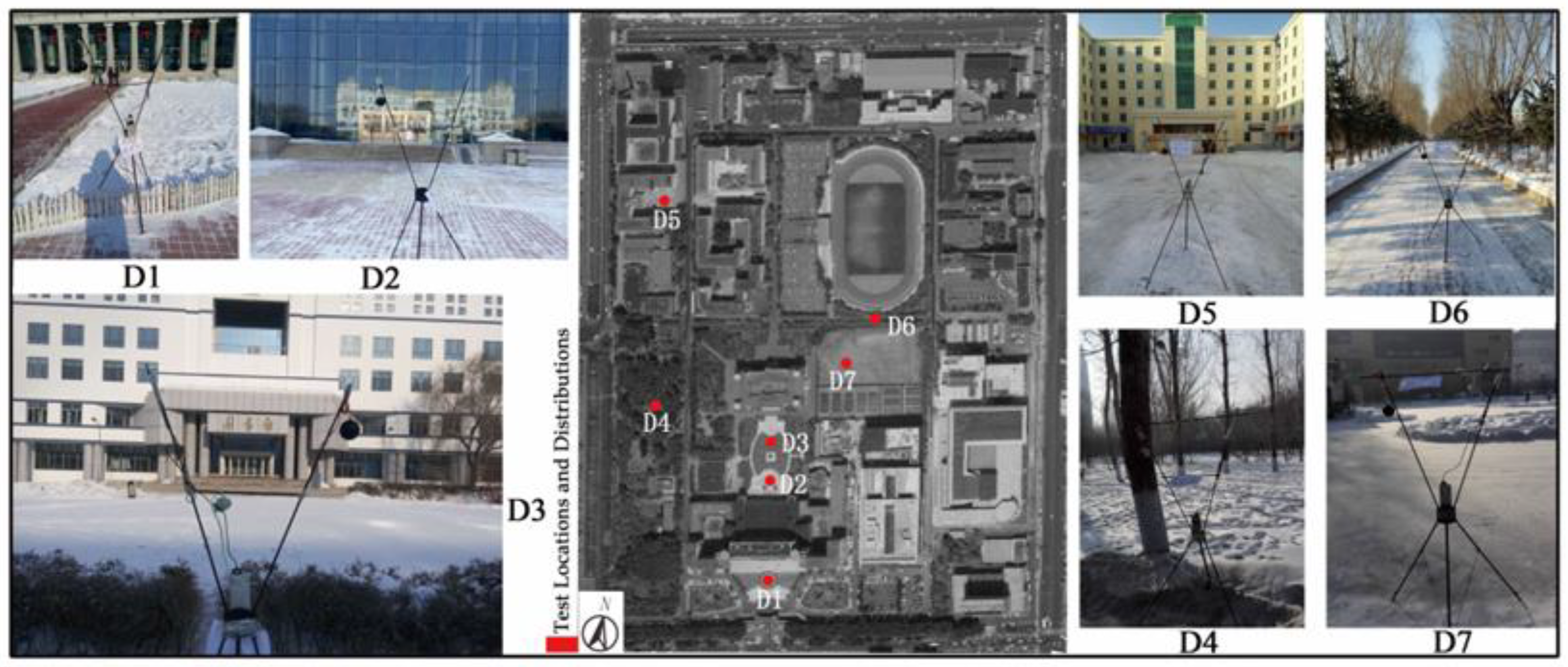
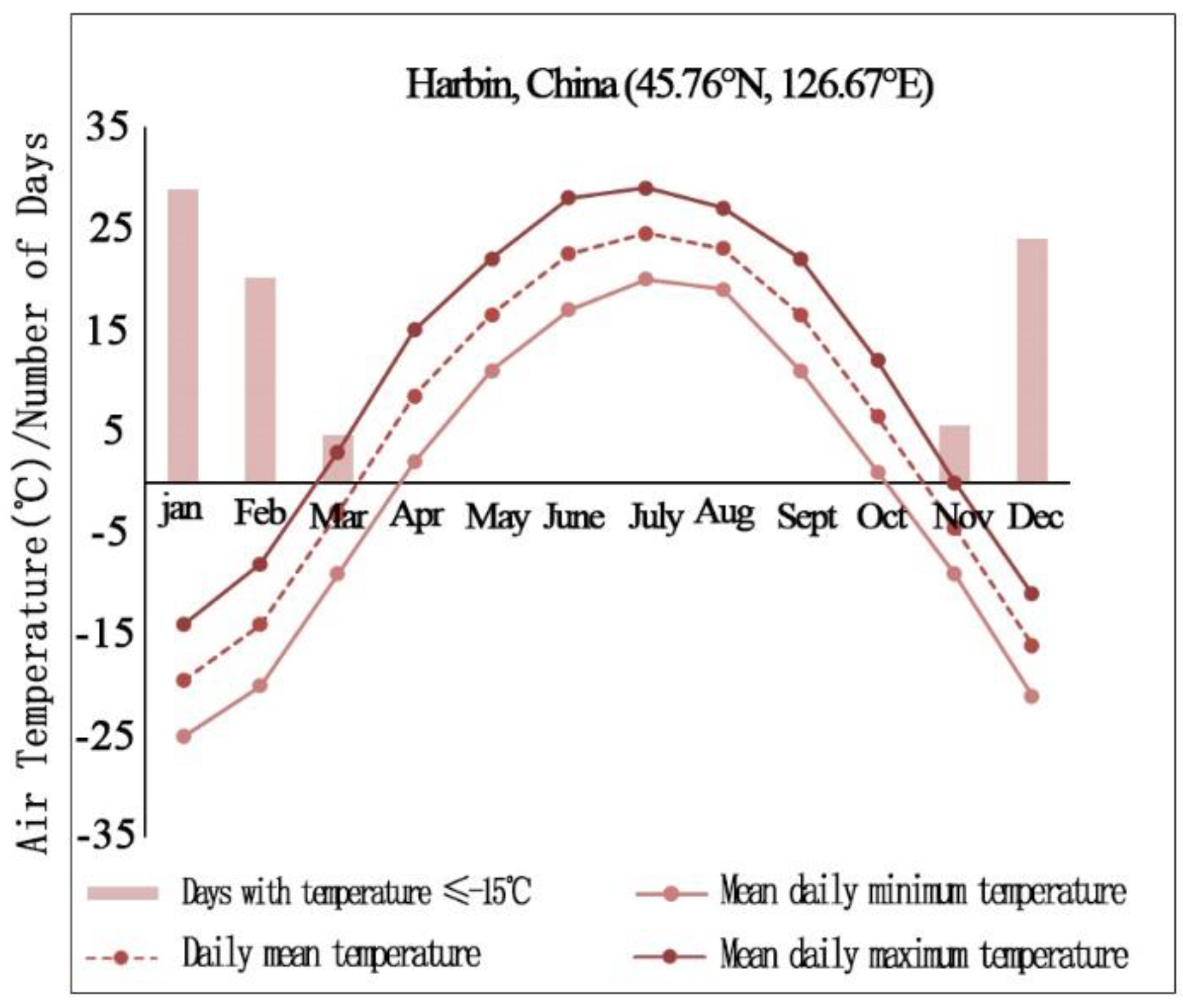
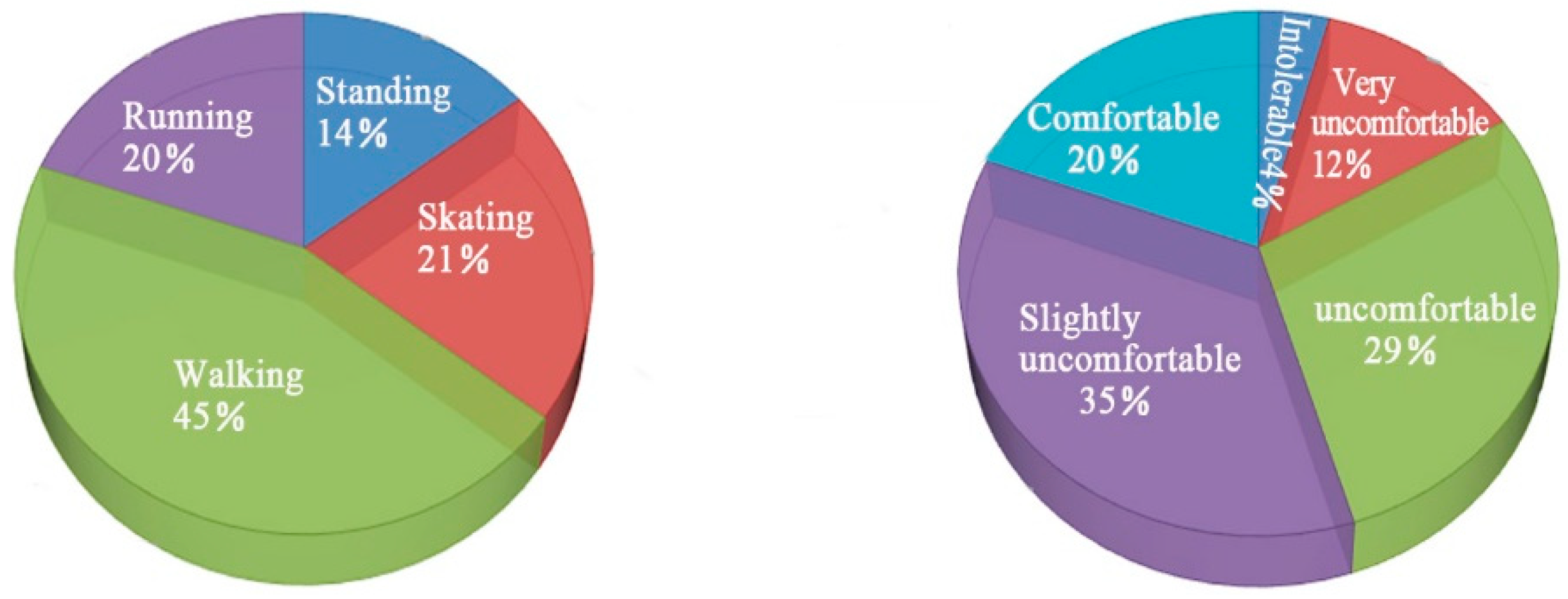


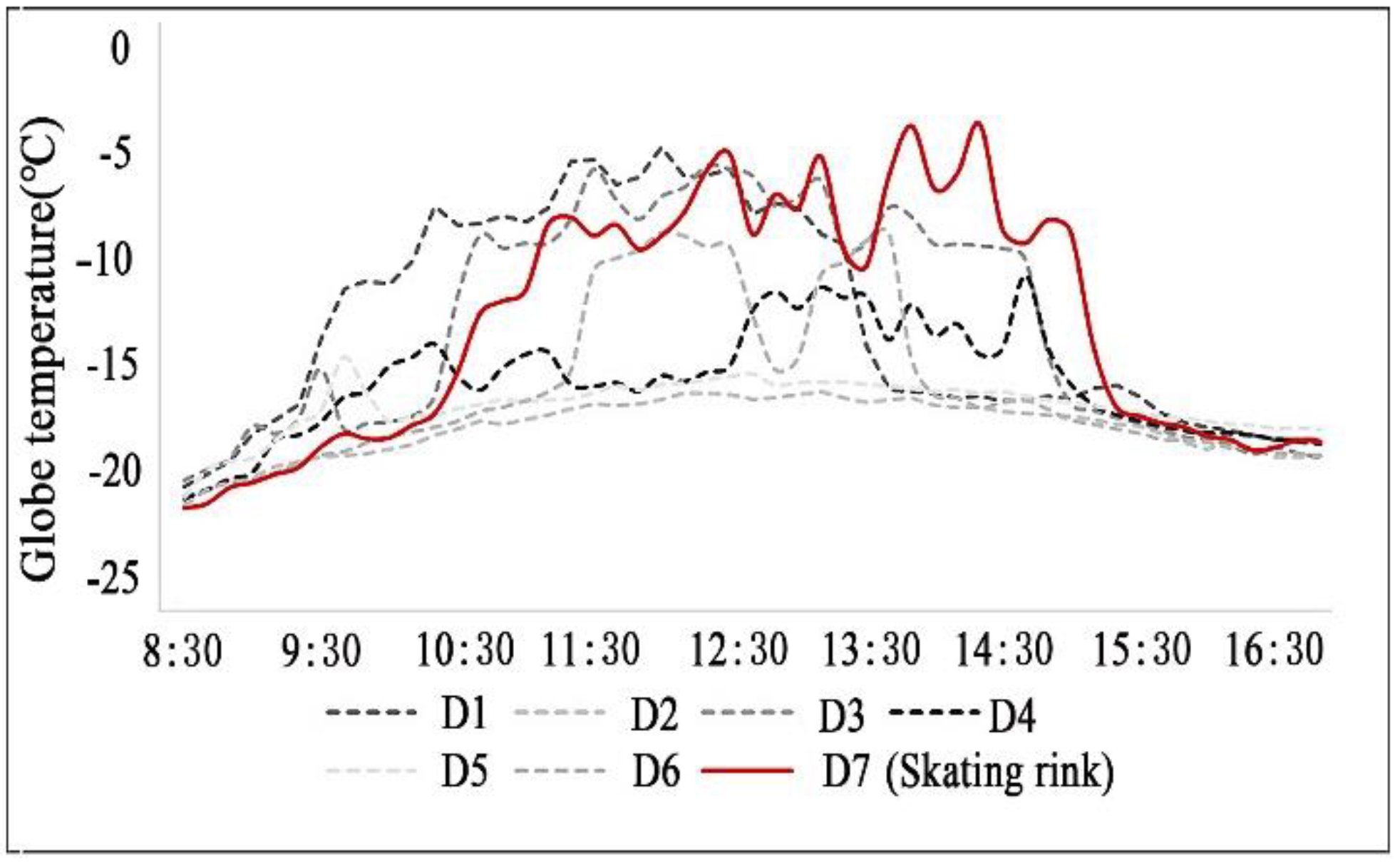


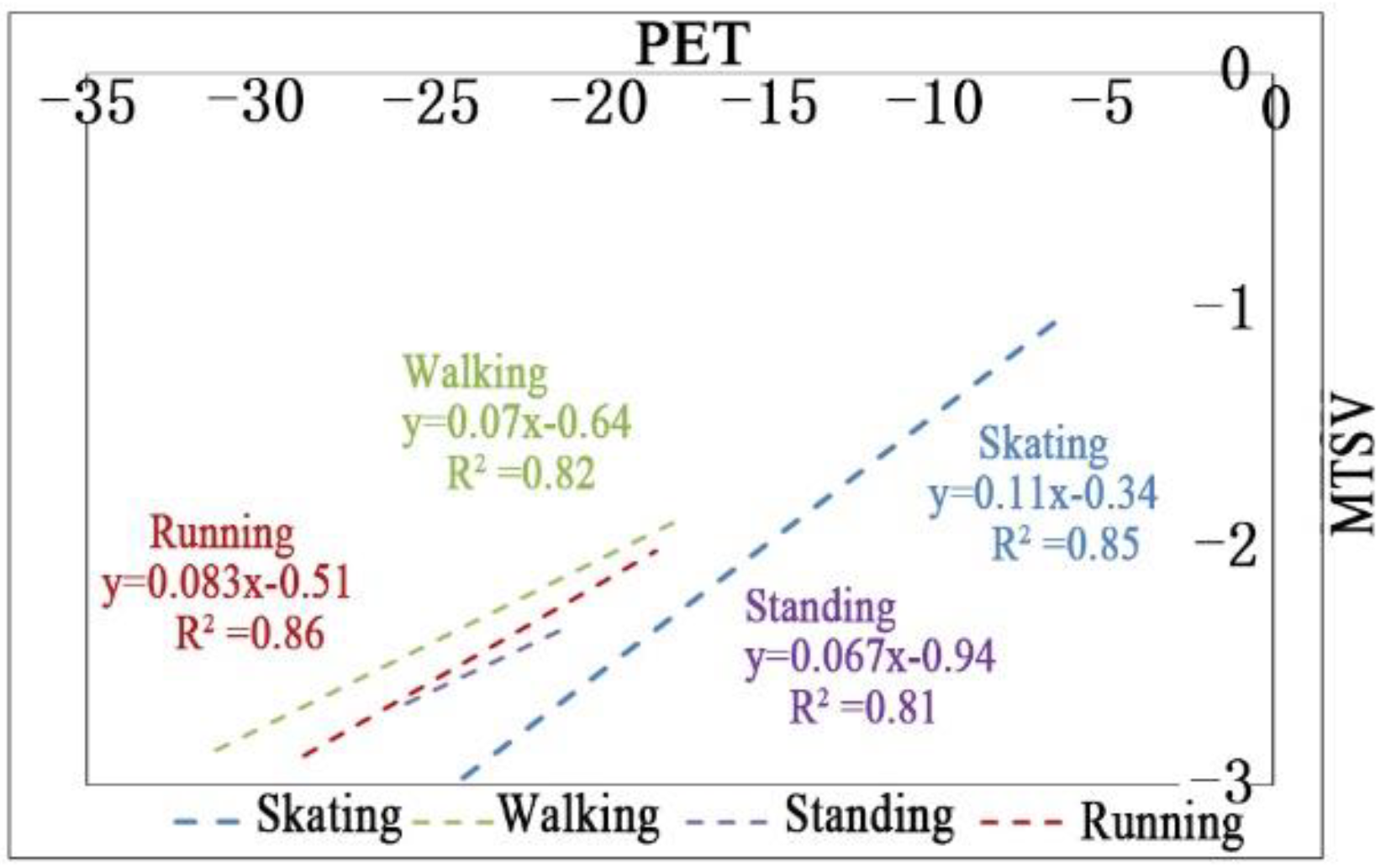
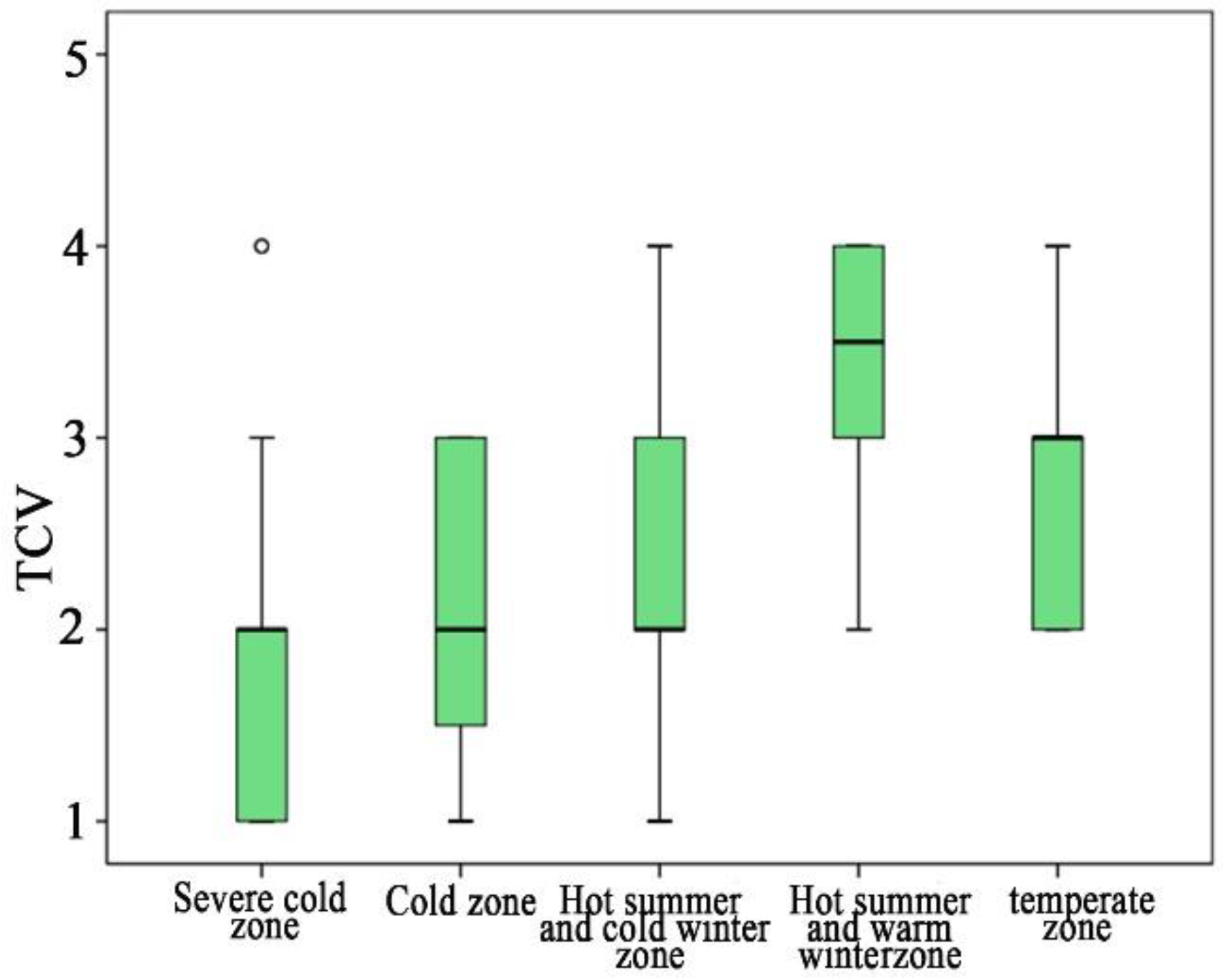
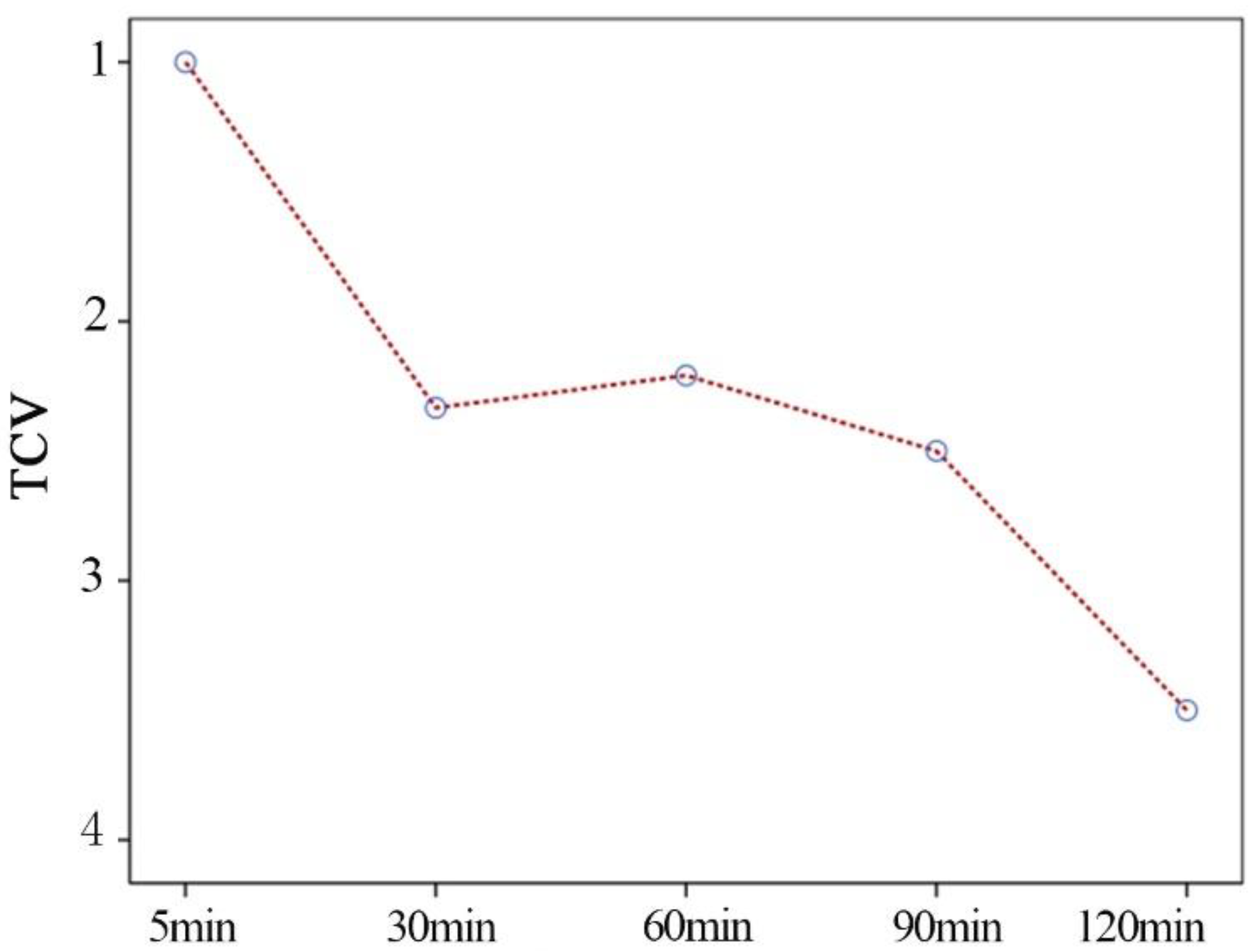
| Ta (°C) | RH (%) | Va (m/s) | Tg (°C) | G (w/m2) | ||
|---|---|---|---|---|---|---|
| Winter | Average Value | −17.02 | 53.78 | 1.03 | −15.86 | 555.1 |
| Maximum Value | −11.33 | 65.90 | 3.02 | −5.85 | 276.3 | |
| Minimum Value | −21.38 | 38.23 | 0.12 | −21.69 | 0 |
| Name and Model | Measuring Range | Accuracy | Sampling Period |
|---|---|---|---|
| BES-01 temperature data collection and record instrument | Temperature: −30–50 °C | ±0.5 °C | 10 s to 24 h |
| BES-02 humiture collection and record instrument | Temperature: −30–50 °C Relative humidity: 0–99% | ±0.5 °C ±3% | 10 s to 24 h |
| YK-2005AH handheld small hot wire anemometer | Wind speed: 0. 4–40 m/s Temperature: −29–+70 °C | ±0.1 m/s ±1.0 °C | 2 s to 12 h |
| SM206 solar radiation tester | 0.1~1999.9 w/m2 | ±10 w/m2 | 2.5 n/s |
| Basic Information Situation (Please Tick or Fill in the Appropriate Item) | |||||
|---|---|---|---|---|---|
| Date | Time | Measuring Site | |||
| Sex | □ Male □ Female | Age | Original residence | ||
| Height | □ 155~160 cm □ 161~170 cm □ 171~180 cm □ ≥181 cm | ||||
| Weight | □ <45 kg □ 46~60 kg □ 61~70 kg □ ≥71 kg | ||||
| Behavioral pattern | □ Sitting □ Standing □ Walking □ Running | ||||
| Outdoor time slot | 8:00–9:00 □ 9:00–10:00 □ 10:00–11:00 □ 11:00–12:00 □ 12:00–13:00 □ 13:00–14:00 □ 14:00–15:00 □ 15:00–16:00 □ 16:00–17:00 □ 17:00–18:00 □ 18:00–19:00 □ | ||||
| Outdoor dwelling time | □ ≤5 min □ 5~30 min □ 30 min~1 h □ 1 h~2 h □ 2~3 h □ ≥3 h | ||||
| Top | □ Coat (thin/thick) □ T-shirt □ Shirt □ Thermal clothing □ Dress □ Sweater □ Thin coat □ Thick coat □ Down jacket □ Cotton jacket □ Thin down vest □ Thick down vest | ||||
| Bottoms | □ Shorts/Skirts □ Trousers/Skirts □ Warm trousers □ Long Johns □ Cotton trousers | ||||
| Shoes | □ Sandals □ Sports shoes □ Leather shoes □ Cotton shoes □ Cloth shoes | ||||
| Hat | Yes □ No □ | ||||
| 1. Your current level of thermal comfort rating (TCV) | ||||||||||||
| 1 | 2 | 3 | 4 | 5 | ||||||||
| Comfortable | Slightly uncomfortable | Uncomfortable | Very uncomfortable | Intolerable | ||||||||
| 2. Your current thermal sensation rating (TSV) | ||||||||||||
| −3 | −2 | −1 | 0 | 1 | 2 | 3 | ||||||
| Very cold | Cold | Slightly cold | Moderate | Slightly warm | Warm | Hot | ||||||
| 3. Evaluation of environmental parameters | ||||||||||||
| Scale | −3 | −2 | −1 | 0 | 1 | 2 | 3 | |||||
| Temperature | Very low | Low | Slightly low | Moderate | Slightly high | High | Very high | |||||
| Wind speed | Very low | Low | Slightly low | Moderate | Slightly high | High | Very high | |||||
| Humidity | Very humid | Humid | Slightly humid | Moderate | Slightly dry | Dry | Very dry | |||||
| Sunlight | Very weak | Weak | Slightly weak | Moderate | Slightly strong | Strong | Very strong | |||||
| Motion State | Skating | Running | Walking | Standing |
|---|---|---|---|---|
| PET neutral temperature | 3 °C | 6 °C | 9 °C | 14 °C |
Publisher’s Note: MDPI stays neutral with regard to jurisdictional claims in published maps and institutional affiliations. |
© 2022 by the authors. Licensee MDPI, Basel, Switzerland. This article is an open access article distributed under the terms and conditions of the Creative Commons Attribution (CC BY) license (https://creativecommons.org/licenses/by/4.0/).
Share and Cite
Qiao, L.; Yan, X. Analysis of Thermal Comfort under Different Exercise Modes in Winter in Universities in Severe Cold Regions. Sustainability 2022, 14, 15796. https://doi.org/10.3390/su142315796
Qiao L, Yan X. Analysis of Thermal Comfort under Different Exercise Modes in Winter in Universities in Severe Cold Regions. Sustainability. 2022; 14(23):15796. https://doi.org/10.3390/su142315796
Chicago/Turabian StyleQiao, Liang, and Xinling Yan. 2022. "Analysis of Thermal Comfort under Different Exercise Modes in Winter in Universities in Severe Cold Regions" Sustainability 14, no. 23: 15796. https://doi.org/10.3390/su142315796




